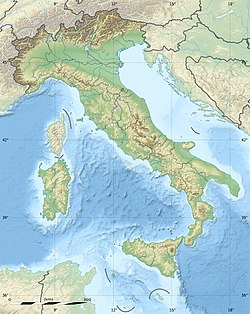Val d'Orcia: Difference between revisions
m WP:BHGbot 6 (List 5): eponymous category first, per MOS:CATORDER; fixed sort key; WP:GENFIXES |
|||
| Line 41: | Line 41: | ||
==In popular culture== |
==In popular culture== |
||
The book ''[[War in Val d'Orcia]]'' by [[Iris Origo]] is a detailed, first-hand account of the World War II events of 1943–1944 in the region, written as a diary in English.<ref>Iris Margaret Origo, Marchioness: ''War in Val d'Orcia. A Diary'' (London: Jonathan Cape, 1947 (British Library details).</ref> |
The book ''[[War in Val d'Orcia]]'' by [[Iris Origo]] is a detailed, first-hand account of the World War II events of 1943–1944 in the region, written as a diary in English.<ref>Iris Margaret Origo, Marchioness: ''War in Val d'Orcia. A Diary'' (London: Jonathan Cape, 1947 (British Library details).</ref> |
||
==Gallery== |
|||
<gallery mode="packed" heights="150"> |
|||
File:Val D Orcia Sunrise (151505625).jpeg |
|||
File:Siena Hills - Montalcino, Siena, Italy - june 23, 2018.jpg |
|||
File:Castiglione-Scenery-2012.JPG |
|||
File:Castiglione d'Orcia, Province of Siena, Tuscany, Italy - panoramio.jpg |
|||
File:Orcia cipressi 001.jpg |
|||
File:San Quirico d'Orcia - lo.tangelini.jpg |
|||
File:Toscana - Val d'Orcia - dalla Via della Foce - Flickr - Oishi Kuranosuke.jpg |
|||
File:Dry and Desolate (Unsplash).jpg |
|||
File:Cypress (257433311).jpeg |
|||
</gallery> |
|||
==References== |
==References== |
||
Revision as of 11:16, 10 October 2020
| UNESCO World Heritage Site | |
|---|---|
 Typical landscape of the Val d'Orcia | |
| Location | Province of Siena, Tuscany, Italy |
| Criteria | Cultural: (iv), (vi) |
| Reference | 1026rev |
| Inscription | 2004 (28th Session) |
| Area | 61,188 ha (151,200 acres) |
| Buffer zone | 5,660 ha (14,000 acres) |
| Website | www |
| Coordinates | 43°04′N 11°33′E / 43.067°N 11.550°E |
The Val d'Orcia or Valdorcia (Italian pronunciation: [valˈdortʃa]) is a region of Tuscany, central Italy, which extends from the hills south of Siena to Monte Amiata. Its gentle, cultivated hills are occasionally broken by gullies and by picturesque towns and villages such as Pienza (rebuilt as an "ideal town" in the 15th century under the patronage of Pope Pius II),[1] Radicofani (home to the notorious brigand-hero Ghino di Tacco) and Montalcino (the Brunello di Montalcino is counted among the most prestigious of Italian wines).[2] Its landscape has been depicted in works of art from Renaissance painting to modern photography.
World Heritage Site
In 2004 the Val d'Orcia was added to the UNESCO list of World Heritage Sites.[3]
Orcia DOC

Within the Val d'Orcia is a strip of land following the Orcia river between the DOCG zones of Brunello di Montalcino and Vino Nobile di Montepulciano. Here the Sangiovese and Trebbiano-based wines are produced under the Orcia Denominazione di origine controllata (DOC) status. The DOC red wine is composed of at least 60 percent Sangiovese with other local varieties, such as Abrusco, permitted to fill in the remainder of the blend. The dry white wine and Vin Santo style DOC wines are composed of at least 50 percent Trebbiano with other local varieties filling out the rest of the blend. All grapes destined for DOC wine production are limited to a maximum harvest yield of 10 tonnes/hectare with the finished wines required to have a minimum alcohol level of at least 12 percent.[4]
Historic railways heritage site
Val d'Orcia is crossed by a nineteenth-century railway, whose tracks, stations and tunnels have been restored to working order. The scenic line connects the small town of Asciano with Monte Antico for tourism purposes, using historic steam engines and carriages.[5]
Film locations
Val d'Orcia has been a location for many well-known films, including:
- 8½ by Federico Fellini (1963)
- Brother Sun, Sister Moon by Franco Zeffirelli (1972)
- Nostalghia by Andrei Tarkovsky (1983)
- The English Patient by Anthony Minghella (1996)
- Stealing Beauty by Bernardo Bertolucci (1996)
- A Midsummer Night's Dream by Michael Hoffman (1999)
- Gladiator by Ridley Scott (2000)
In popular culture
The book War in Val d'Orcia by Iris Origo is a detailed, first-hand account of the World War II events of 1943–1944 in the region, written as a diary in English.[6]
Gallery
References
- ^ Haegen, Anne Mueller von der; Strasser, Ruth F. (2013). "Pienza". Art & Architecture: Tuscany. Potsdam: H.F.Ullmann Publishing. pp. 394–395. ISBN 978-3-8480-0321-1. Retrieved 18 May 20119.]
- ^ Discusses vintages etc. Retrieved 18 May 2019.
- ^ Nomination document Retrieved 18 May 2019.
- ^ Saunders, Peter Lionel (2004). Wine label language. Firefly Books Ltd. p. 188. ISBN 978-1-55297-720-0.
- ^ Tourism guide Retrieved 18 May 2019.
- ^ Iris Margaret Origo, Marchioness: War in Val d'Orcia. A Diary (London: Jonathan Cape, 1947 (British Library details).
External links
- Val d'Orcia Natural Park (Official page)
- The Val d'Orcia Natural Artistic and Cultural Park - turismo.intoscana.it
- UNESCO World Heritage Centre :: Val d’Orcia
- Montalcino and Val d'Orcia Travel tips and updated events from Montalcino and Val d'Orcia
- Val d’Orcia Landscape
- Many of the finest photos of Val d'Orcia
- Val d'Orcia: a natural masterpiece by Intoscana.it
- Heritage railways in Val d'Orcia. The Asciano-Monte Antico line










